Thermo Fisher Scientific AgPath-ID One Step RT PCR Reagents Mode d'emploi
- Taper
- Mode d'emploi

For Veterinary Use Only.
AgPath-ID™ One‑Step RT‑PCR Reagents
USER GUIDE
Core reagents for one-step qRT-PCR detection of pathogens
Catalog Numbers AM1005, 4387424, and 4387391
Publication Number 1005M
Revision J

Life Technologies Corporation | 2130 Woodward Street | Austin, TX 78744
For descriptions of symbols on product labels or product documents, go to thermofisher.com/symbols-definition.
The information in this guide is subject to change without notice.
DISCLAIMER: TO THE EXTENT ALLOWED BY LAW, THERMO FISHER SCIENTIFIC INC. AND/OR ITS AFFILIATE(S) WILL NOT BE LIABLE FOR SPECIAL,
INCIDENTAL, INDIRECT, PUNITIVE, MULTIPLE, OR CONSEQUENTIAL DAMAGES IN CONNECTION WITH OR ARISING FROM THIS DOCUMENT,
INCLUDING YOUR USE OF IT.
Revision history: Pub. No. 1005M
Revision Date Description
J 27 August 2019
• Updated to the current document template, with associated updates to the warranty, trademarks,
and logos.
• Removed Detection Enhancer from “Contents and storage“ on page 4.
H March 2015
•Clarified that the kit is intended for use with single or duplex assays.
• Other format, style, and legal updates.
G October 2012 Baseline for this revision history.
Important Licensing Information: These products may be covered by one or more Limited Use Label Licenses. By use of these products, you accept
the terms and conditions of all applicable Limited Use Label Licenses.
TRADEMARKS: All trademarks are the property of Thermo Fisher Scientific and its subsidiaries unless otherwise specified.
©2019 Thermo Fisher Scientific Inc. All rights reserved.

Contents
■CHAPTER 1 Product information ....................................... 4
Product description ............................................................. 4
Contents and storage ............................................................ 4
Required materials not supplied .................................................. 5
Guidelines for input RNA ......................................................... 5
Guidelines for PCR primer/TaqMan® probe mix ..................................... 6
■CHAPTER 2 Methods ..................................................... 7
Set up the real‑time PCR instrument .............................................. 7
Prepare the RT-PCR reactions .................................................... 7
Perform RT-PCR, then analyze the results ......................................... 9
■APPENDIX A Troubleshooting ......................................... 10
■APPENDIX B Supplemental information .............................. 11
Good laboratory practices for PCR and RT-PCR .................................... 11
■APPENDIX C Safety ..................................................... 12
Chemical safety ................................................................ 13
■APPENDIX D Documentation and support ............................ 15
Customer and technical support ................................................. 15
Limited product warranty ....................................................... 15
AgPath-ID
™
One‑Step RT‑PCR Reagents User Guide
3

Product information
IMPORTANT! Before using this product, read and understand the information in the
“Safety” appendix in this document.
Product description
AgPath-ID™ One-Step RT-PCR Reagents are designed for sensitive, robust
amplication of RNA targets using a single-tube TaqMan®-based real-time RT-PCR
strategy. Each kit is optimized for use with single or duplex TaqMan® primer/probe
sets.
Each kit includes the following reagents:
•25X RT-PCR Enzyme Mix: Contains ArrayScript™ Reverse Transcriptase and
AmpliTaq Gold™ DNA Polymerase.
•2X RT-PCR Buer: Includes ROX™ passive reference dye for quantitative
uorescent signal normalizaton.
For higher order multiplexed assays or samples that have been extracted from
matrices with high inhibitor content (such as fecal samples and oral uids), use the
Path-ID™ Multiplex One-Step RT-PCR Kit (Cat. No. 4442136).
Contents and storage
Component Cat. No. AM1005
(100 reactions)
Cat. No. 4387424
(500 reactions)
Cat. No. 4387391
(1,000 reactions) Storage
2X RT-PCR Buffer 1375 µL 7 mL 14 mL −10°C to −30°C in a
non‑frost‑free freezer
25X RT-PCR Enzyme Mix 110 µL 550 µL 1100 µL
Nuclease-free water 1.75 µL 25 mL 25 mL —
1
4
AgPath-ID
™
One‑Step RT‑PCR Reagents User Guide

Required materials not supplied
Unless otherwise indicated, all materials are available through thermosher.com.
MLS: Fisher Scientic (sherscientic.com) or other major laboratory supplier.
Item Source
Real‑time PCR system, one of the following:
QuantStudio™ 5 Real-Time PCR System
Contact your local sales
office.
Applied Biosystems™ 7500 Fast Real-Time PCR System
Applied Biosystems™ 7500 Real-Time PCR System
Applied Biosystems™ 7900HT Fast Real‑Time PCR System
ABI PRISM™ 7500 Sequence Detection System
MX3000P QPCR System Agilent
SmartCycler™ II System Cepheid
Equipment
Adjustable pipettors MLS
Reagents
(Optional)
Detection Enhancer[1]
Detection Enhancer ‑ 100 rxn A44810
Detection Enhancer ‑ 500 rxn A44941
Detection Enhancer ‑ 1000 rxn A44811
Tubes, plates, and other consumables
96‑well PCR plate or tubes thermofisher.com/plastics
Nuclease‑free pipette tips thermofisher.com/
pipettetips
Reagent reservoirs or tubes[2] MLS
[1] Recommended for targets with high GC content and/or persistent secondary structure.
[2] Recommended for preparing the RT‑PCR master mix.
Guidelines for input RNA
• Use pure RNA that is free of RT-PCR inhibitors.
• We recommend using a MagMAX™ RNA isolation kit that is appropriate for your
sample type. Go to thermosher.com, then search for
MagMAX
.
• For cell-free sample types, such as serum, we recommend using the MagMAX™
CORE Nucleic Acid Purication Kit (Cat. No. A32700 or A32702).
Chapter 1 Product information
Required materials not supplied
1
AgPath-ID
™
One‑Step RT‑PCR Reagents User Guide
5

Guidelines for PCR primer/TaqMan® probe mix
• Single and duplex TaqMan® primer/probe sets must be compatible with your
real-time PCR instrument and designed for one-step RT-PCR.
• Optimize the concentrations of primers and probe for your experiment. See
Table 1 for recommended starting concentrations.
• The reverse transcriptase that is contained in the kit is produced using an E. coli
expression vector. The vector contains a proprietary version of the MMLV pol
gene (GenBank™ accession no. J02255) expressed from pET-24(+). It is possible
that a minimal amount of the expression vector could be carried over into the
nal master mix formulation. If you are targeting MMLV, a related virus, or any
of the plasmid sequences, we recommend designing primer sequences that are
not contained in the expression vector.
Table 1 Recommended PCR Primer/TaqMan® probe concentrations
Component Final concentration in the
reaction 25X primer/probe mix[1]
Forward PCR primer 400 nM 10 µM
Reverse PCR primer 400 nM 10 µM
TaqMan® probe 120 nM 3 µM
[1] Use 1 µL of PCR primer/TaqMan® probe mix per 25‑µL RT-PCR reaction.
Chapter 1 Product information
Guidelines for PCR primer/TaqMan
®
probe mix
1
6
AgPath-ID
™
One‑Step RT‑PCR Reagents User Guide

Methods
Set up the real‑time PCR instrument
See the appropriate instrument user guide for detailed instructions to program the
thermal-cycling conditions.
Set up the thermal protocol for your instrument according to one of the following
tables.
• Passive reference dye: ROX™ (included in the RT-PCR Buer)
• Reaction volume: 25 µL
IMPORTANT! If you are using the SmartCycler™ II instrument, set ramp rates to
1.6°C/sec to prevent amplication failure.
Table 2 Thermal protocol: SmartCycler™ II instrument
Step Stage Cycles Temp Time
Reverse transcription 1 1 45°C[1] 10 min
RT inactivation/initial denaturation 2 1 95°C 15 min
Amplification 3 40 95°C
60°C
15 sec
60 sec
[1] 50°C may be a more effective RT temperature for some PCR primer sets.
Table 3 Thermal protocol: All other compatible instruments
Step Stage Cycles Temp Time
Reverse transcription 1 1 45°C 10 min
RT inactivation/initial denaturation 2 1 95°C 10 min
Amplification 3 40 95°C
60°C
15 sec
45 sec
Prepare the RT-PCR reactions
• Calculate the number of required reactions. Scale reaction components based on
the single-reaction volumes, then include 5–10% overage, unless otherwise
indicated.
• Include duplicate no template controls (NTCs) using nuclease-free water in place
of sample.
2
AgPath-ID
™
One‑Step RT‑PCR Reagents User Guide
7

1. Prepare each RT-PCR master mix on ice according to Table 4.
2. Transfer the appropriate volume of RT-PCR master mix to a PCR plate or tubes.
3. Add samples or controls to the wells or tubes containing RT-PCR master mix
(25 µL nal volume per reaction).
Table 4 RT‑PCR reaction mix volumes
Component Volume
RT‑PCR master mix
2X RT‑PCR Buffer 12.5 µL
Forward and reverse PCR primers __ µL
TaqMan® probes __ µL
25X RT‑PCR Enzyme Mix 1 µL
(Optional)
Detection Enhancer[1] (1.67 µL)
RNA sample (or nuclease‑free water for NTCs) __ µL
Total volume per reaction 25 µL
[1] Run the first reaction without Detection Enhancer. Detection Enhancer is recommended only for targets with
high GC content and/or persistent secondary structure. Detection Enhancer can compromise sensitivity for
other targets. For more information, see Appendix A, “Troubleshooting“.
Chapter 2 Methods
Prepare the RT-PCR reactions
2
8
AgPath-ID
™
One‑Step RT‑PCR Reagents User Guide

Perform RT-PCR, then analyze the results
Start the run, then analyze the RT-PCR data according to the PCR instrument
manufacturer’s instructions.
Figure 1 Amplification of a control RNA sequence using AgPath-ID™ One‑Step RT‑PCR
Reagents
For the amplification, 5 µL of Xeno™ RNA-01 Control dilutions, containing 107, 106, 105, 104,
2500, 640, 160, 80, 40, and 20 RNA molecules, were amplified using the kit on an Applied
Biosystems™ 7900HT Fast Real‑Time PCR System. The amplification plots are shown with an
inset that displays the linear relationship between Ct and RNA input; the slope is ~3.39, which
indicates ~100% amplification efficiency.
Chapter 2 Methods
Perform RT-PCR, then analyze the results
2
AgPath-ID
™
One‑Step RT‑PCR Reagents User Guide
9

Troubleshooting
Observation Possible cause Recommended action
No signal from samples that
are expected to be positive
The target sequence has high
GC content or persistent
secondary structure.
Include Detection Enhancer in the RT-PCR
master mix to improve amplification.
Add 1.67 µL of Detection Enhancer per 25-µL
reaction.
Inhibitors are present in the
RNA sample.
Isolate RNA using the appropriate MagMAX™
kit. MagMAX™ kits are typically more effective
than glass fiber filter-based RNA isolation
methods or TRI Reagent™.
For samples that contain minimal amounts of
inhibitors, decrease the volume of sample
added to the reaction, then repeat RT‑PCR.
Dilute the sample 5‑ or 10‑fold, then repeat
RT‑PCR.
There were problems with the
RNA isolation procedure.
For viral RNA isolation, if a carrier RNA was
used, check the concentration of the carrier
RNA to evaluate its recovery.
For user-designed assays, the
assay concentration was
improperly optimized with RT-
PCR Buffer.
Optimize the assay concentration.
The thermal cycler was not
programmed correctly.
Check the thermal protocol on the instrument
to ensure that the appropriate settings are
configured.
The RT-PCR master mix was
not prepared correctly.
Prepare new RT‑PCR master mix, then repeat
RT‑PCR.
25X RT-PCR Enzyme Mix was
stored improperly and lost
activity.
Store reagents as directed.
Signal detected in no template
control (NTC)
Contamination occurred during
RT-PCR.
Repeat the qRT-PCR reaction with fresh
reagents and decontaminated pipettes.
Follow “Good laboratory practices for PCR and
RT-PCR“ on page 11.
It is possible that a minimal amount of the
expression vector could be carried over into
the final master mix formulation. If you are
targeting MMLV, a related virus, or any of the
plasmid sequence, we recommend designing
primer sequences that are not contained in the
expression vector.
A
10
AgPath-ID
™
One‑Step RT‑PCR Reagents User Guide

Supplemental information
Good laboratory practices for PCR and RT-PCR
• Wear clean gloves and a clean lab coat.
– Do not wear the same gloves and lab coat that you have previously used
when handling amplied products or preparing samples.
• Change gloves if you suspect that they are contaminated.
• Maintain separate areas and dedicated equipment and supplies for:
– Sample preparation and reaction setup.
–Amplication and analysis of products.
• Do not bring amplied products into the reaction setup area.
• Open and close all sample tubes carefully. Avoid splashing or spraying samples.
• Keep reactions and components capped as much as possible.
• Use a positive-displacement pipeor or aerosol-resistant barrier pipee tips.
• Clean lab benches and equipment periodically with 10% bleach solution or DNA
decontamination solution.
B
AgPath-ID
™
One‑Step RT‑PCR Reagents User Guide
11

Safety
WARNING! GENERAL SAFETY. Using this product in a manner not specied
in the user documentation may result in personal injury or damage to the
instrument or device. Ensure that anyone using this product has received
instructions in general safety practices for laboratories and the safety
information provided in this document.
·Before using an instrument or device, read and understand the safety
information provided in the user documentation provided by the
manufacturer of the instrument or device.
·Before handling chemicals, read and understand all applicable Safety Data
Sheets (SDSs) and use appropriate personal protective equipment (gloves,
gowns, eye protection, and so on). To obtain SDSs, see the “Documentation
and Support” section in this document.
C
12
AgPath-ID
™
One‑Step RT‑PCR Reagents User Guide

Chemical safety
WARNING! GENERAL CHEMICAL HANDLING. To minimize hazards,
ensure laboratory personnel read and practice the general safety guidelines for
chemical usage, storage, and waste provided below. Consult the relevant SDS
for specic precautions and instructions:
·Read and understand the Safety Data Sheets (SDSs) provided by the
chemical manufacturer before you store, handle, or work with any chemicals
or hazardous materials. To obtain SDSs, see the "Documentation and
Support" section in this document.
·Minimize contact with chemicals. Wear appropriate personal protective
equipment when handling chemicals (for example, safety glasses, gloves, or
protective clothing).
·Minimize the inhalation of chemicals. Do not leave chemical containers open.
Use only with sucient ventilation (for example, fume hood).
·Check regularly for chemical leaks or spills. If a leak or spill occurs, follow
the manufacturer cleanup procedures as recommended in the SDS.
·Handle chemical wastes in a fume hood.
·Ensure use of primary and secondary waste containers. (A primary waste
container holds the immediate waste. A secondary container contains spills
or leaks from the primary container. Both containers must be compatible
with the waste material and meet federal, state, and local requirements for
container storage.)
·After emptying a waste container, seal it with the cap provided.
·Characterize (by analysis if needed) the waste generated by the particular
applications, reagents, and substrates used in your laboratory.
·Ensure that the waste is stored, transferred, transported, and disposed of
according to all local, state/provincial, and/or national regulations.
·IMPORTANT! Radioactive or biohazardous materials may require special
handling, and disposal limitations may apply.
AVERTISSEMENT ! PRÉCAUTIONS GÉNÉRALES EN CAS DE
MANIPULATION DE PRODUITS CHIMIQUES. Pour minimiser les risques,
veiller à ce que le personnel du laboratoire lise aentivement et mee en œuvre
les consignes de sécurité générales relatives à l’utilisation et au stockage des
produits chimiques et à la gestion des déchets qui en découlent, décrites ci-
dessous. Consulter également la FDS appropriée pour connaître les précautions
et instructions particulières à respecter :
·Lire et comprendre les ches de données de sécurité (FDS) fournies par le
fabricant avant de stocker, de manipuler ou d’utiliser les matériaux
dangereux ou les produits chimiques. Pour obtenir les FDS, se reporter à la
section « Documentation et support » du présent document.
·Limiter les contacts avec les produits chimiques. Porter des équipements de
protection appropriés lors de la manipulation des produits chimiques (par
exemple : lunees de sûreté, gants ou vêtements de protection).
·Limiter l’inhalation des produits chimiques. Ne pas laisser les récipients de
produits chimiques ouverts. Ils ne doivent être utilisés qu’avec une
ventilation adéquate (par exemple, sorbonne).
Appendix C Safety
Chemical safety
C
AgPath-ID
™
One‑Step RT‑PCR Reagents User Guide
13

·Vérier régulièrement l’absence de fuite ou d’écoulement des produits
chimiques. En cas de fuite ou d’écoulement d’un produit, respecter les
directives de neoyage du fabricant recommandées dans la FDS.
·Manipuler les déchets chimiques dans une sorbonne.
·Veiller à utiliser des récipients à déchets primaire et secondaire. (Le récipient
primaire contient les déchets immédiats, le récipient secondaire contient les
fuites et les écoulements du récipient primaire. Les deux récipients doivent
être compatibles avec les matériaux mis au rebut et conformes aux exigences
locales, nationales et communautaires en matière de connement des
récipients.)
·Une fois le récipient à déchets vidé, il doit être refermé hermétiquement avec
le couvercle fourni.
·Caractériser (par une analyse si nécessaire) les déchets générés par les
applications, les réactifs et les substrats particuliers utilisés dans le
laboratoire.
·Vérier que les déchets sont convenablement stockés, transférés, transportés
et éliminés en respectant toutes les réglementations locales, nationales et/ou
communautaires en vigueur.
·IMPORTANT ! Les matériaux représentant un danger biologique ou
radioactif exigent parfois une manipulation spéciale, et des limitations
peuvent s’appliquer à leur élimination.
Appendix C Safety
Chemical safety
C
14
AgPath-ID
™
One‑Step RT‑PCR Reagents User Guide

Documentation and support
Customer and technical support
Visit thermosher.com/support for the latest service and support information.
• Worldwide contact telephone numbers
• Product support information
– Product FAQs
– Software, patches, and updates
– Training for many applications and instruments
• Order and web support
• Product documentation
– User guides, manuals, and protocols
–Certicates of Analysis
– Safety Data Sheets (SDSs; also known as MSDSs)
Note: For SDSs for reagents and chemicals from other manufacturers,
contact the manufacturer.
Limited product warranty
Life Technologies Corporation and/or its aliate(s) warrant their products as set forth
in the Life Technologies' General Terms and Conditions of Sale at
www.thermosher.com/us/en/home/global/terms-and-conditions.html. If you have
any questions, please contact Life Technologies at www.thermosher.com/support.
D
AgPath-ID
™
One‑Step RT‑PCR Reagents User Guide
15
-
 1
1
-
 2
2
-
 3
3
-
 4
4
-
 5
5
-
 6
6
-
 7
7
-
 8
8
-
 9
9
-
 10
10
-
 11
11
-
 12
12
-
 13
13
-
 14
14
-
 15
15
-
 16
16
Thermo Fisher Scientific AgPath-ID One Step RT PCR Reagents Mode d'emploi
- Taper
- Mode d'emploi
dans d''autres langues
Documents connexes
-
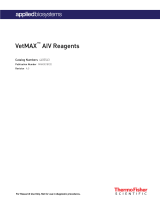 Thermo Fisher Scientific VetMAX AIV Reagents Mode d'emploi
Thermo Fisher Scientific VetMAX AIV Reagents Mode d'emploi
-
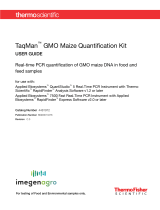 Thermo Fisher Scientific TaqMan GMO Maize Quantification Kit Mode d'emploi
Thermo Fisher Scientific TaqMan GMO Maize Quantification Kit Mode d'emploi
-
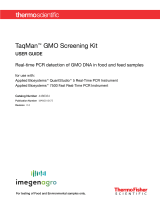 Thermo Fisher Scientific TaqMan GMO Screening Kit Mode d'emploi
Thermo Fisher Scientific TaqMan GMO Screening Kit Mode d'emploi
-
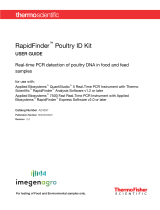 Thermo Fisher Scientific RapidFinder Poultry ID Kit Mode d'emploi
Thermo Fisher Scientific RapidFinder Poultry ID Kit Mode d'emploi
-
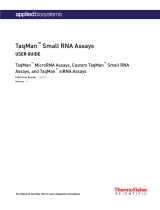 Thermo Fisher Scientific TaqMan Small RNA Assays Mode d'emploi
Thermo Fisher Scientific TaqMan Small RNA Assays Mode d'emploi
-
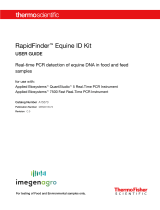 Thermo Fisher Scientific RapidFinder Equine ID Kit Mode d'emploi
Thermo Fisher Scientific RapidFinder Equine ID Kit Mode d'emploi
-
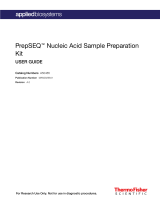 Thermo Fisher Scientific PrepSEQ Nucleic Acid Sample Preparation Kit Mode d'emploi
Thermo Fisher Scientific PrepSEQ Nucleic Acid Sample Preparation Kit Mode d'emploi
-
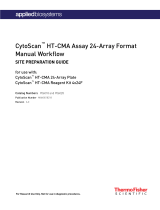 Thermo Fisher Scientific CytoScan HT-CMA Assay 24-Array Format Le manuel du propriétaire
Thermo Fisher Scientific CytoScan HT-CMA Assay 24-Array Format Le manuel du propriétaire
-
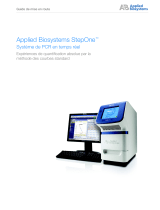 Thermo Fisher Scientific Applied Biosystems StepOne™ Système Le manuel du propriétaire
Thermo Fisher Scientific Applied Biosystems StepOne™ Système Le manuel du propriétaire
-
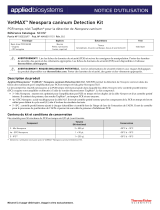 Thermo Fisher Scientific VetMAX Neospora caninum Mode d'emploi
Thermo Fisher Scientific VetMAX Neospora caninum Mode d'emploi


























